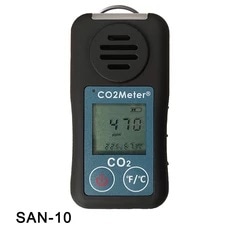
Halloween can tend to bring an abundance of spooky special effects, from dry ice to creepy crawling fog displays. However, what you may not know about these special effects is that the main component in their creation is Carbon Dioxide (CO2).
While Carbon Dioxide (CO2) plays an integral role in producing theatrical smoke and fog, these atmospheric portrayals while they may be prevalent, can also be dangerous.
How are Halloween Special Effects Created?
Many special effects which are used in theatrics are created by a special formulated mixture designed to be used with CO2, which creates a thicker, more consistent display. In addition, liquid CO2 stored in compressed cylinders can also be used in conjunction with a fog machine to produce "low-lying" fog effects. When liquid CO2 is used, it essentially "chills" the fog, and the result you see is the thick cloud that stays within a few feet of the ground - perfect for capturing that Halloween "spookiness"!
The benefits of using a carbon dioxide based special effect, is that you can't taste or smell the gas and it will quickly disappear into the air. However, larger smoke and special effects created with liquid CO2, have been known to create negative health effects if proper CO2 monitoring is not present.
Aside from just creating fog, dry ice is also used as a means of experimentation around holidays such as Halloween. As opposed to the liquid form, the solid form of CO2 is dry ice and produced by heating water to or near boiling in a suitable container. As CO2 cannot exist as a liquid in atmospheric pressure, the dry ice diverts and instantly produces a gas, condensing water vapor and creating a thick white fog.
While Halloween may be the perfect time for mimicking dry ice and fog for real eye-catching science, our staff at GasLab wants to ensure you are protected even among the most bubbly of concoctions!
CO2 Dry Ice and Fog Safety
When utilizing dry ice or fog effects it is first good to note, that under atmospheric conditions CO2 is a gas. Most of the air we breathe is Nitrogen (79%) and Oxygen (20%). However, dry ice turns directly into carbon dioxide gas which can be hazardous to our health and lead to dizziness, fatigue, headache and in liquid form, even result in burns if not properly handled.
To ensure your safety, dry ice should always be handled specifically with care, as CO2 has to be cooled to at least -109.3°F at extreme temperatures. Our team recommends the use of gloves or tongs to always be implemented. If you do not handle dry ice properly, the end results could be severe causing freezing of skin and severe burns.
Also it is wise to never place dry ice in a sealed or closed container, as it will form into a gas and result in explosion. Keep in mind to handle liquid CO2 with protectively, and ensure safety around others in being aware of your surroundings to ensure there is proper ventilation in the space.
CO2 Safety Alarm

To protect yourself and others near high levels of CO2 in theatrical or special effect experimentation, GasLab offers a specific Personal 5% CO2 Safety Monitor to protect against high levels of CO2. The SAN-10 can be used in enclosed areas where CO2 buildup may cause personal injury.
These personal monitors also feature audible, visual and vibrating alarms - not to mention accelerometer technology that is triggered when an employee could potentially occur.
If you work more around larger theatrical environments or venues, GasLab also provides a fixed/wall mounted device such as the CO2 Storage Safety Alarm or RAD-0102-6. This device is designed to protect customers and employees around bulk CO2 or anywhere compressed CO2 is stored or produced. The monitor features audible and visual indicators, and meets all local fire codes while being able to control an exhaust fan or send an alarm to first-responders.
Let's face it, who does not like a smoking pumpkin or a creepy low-lying fog upon trick-o-treating? It's easy to make your favorite Halloween experiment and gain all the "oohs" and "aahs".
Just remember that safety comes first and ensure you and those around you are always protected.
For more Halloween fun with CO2, here's a list of our favorite experiments:
- Spooky expanding ghost experiment
- Oozing pumpkin CO2 volcano experiment
- Giant dry ice CO2 bubble sphere
- Boo bubbles and exploding pumpkins
- Low lying CO2 spooky fog effects
Source: https://gaslab.com/